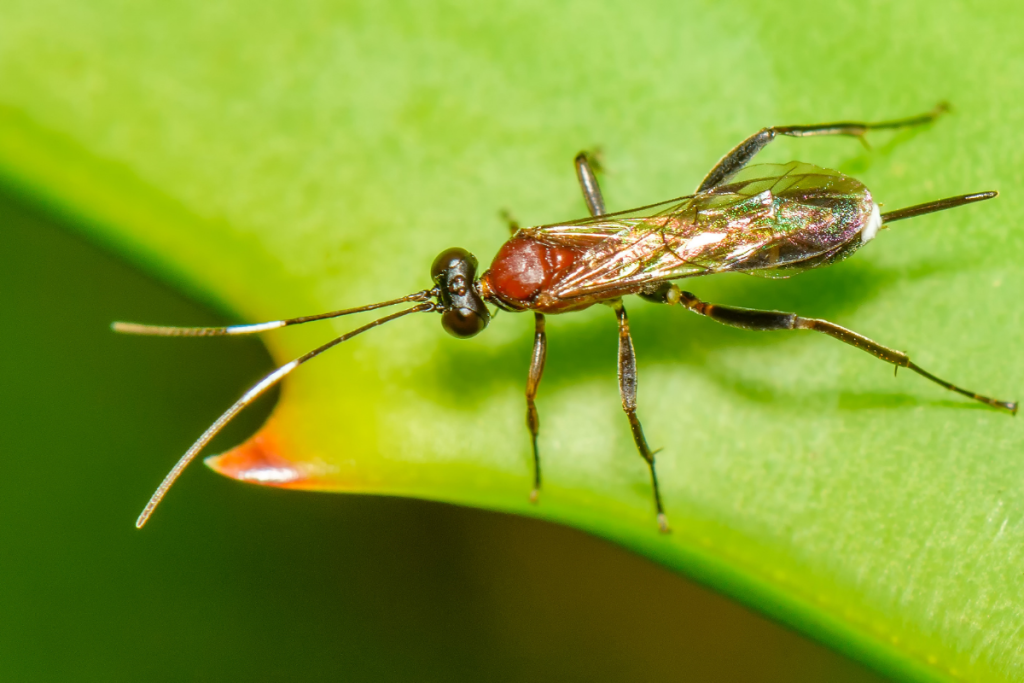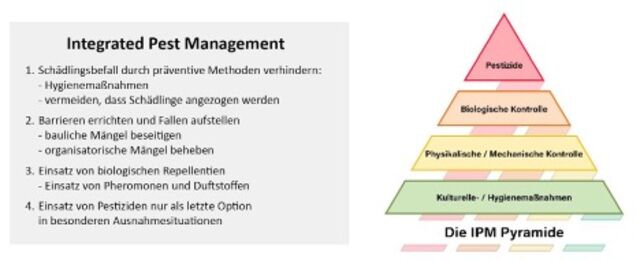CHEMICAL AND BIOLOGICAL PEST CONTROL - DIFFERENCES AT A GLANCE
- Verfasst von Daniel Schröer
- 7 min. Lesezeit
- Pest Control

Even today, pest controllers often react to a pest infestation with the chemical club – poison baits against rats and mice, synthetic neurotoxins (pyrethroids) against flour moths, acaricides against mites, etc. Even for prevention, the use of chemical agents was common practice for a long time (and in some cases still is). However, the legal regulations surrounding the use of biocides and pesticides are becoming increasingly stringent. This particularly affects the food industry, but also other sectors.
Due to this trend, alternatives to chemical pest control are becoming more and more important. A possible alternative lies in biological pest control. In this article, you will learn exactly what is meant by this and when which approach is suitable.
THIS IS WHAT IS MEANT BY CHEMICAL PEST CONTROL
In chemical pest control, as the name suggests, chemicals are used to target specific organisms. There is a poison against every pest or group of pests (rodenticides against rodents, insecticides against insects, etc.).
Often, chemical pest control is considered particularly effective. However, it is only when …
- the right chemicals,
- in the right quantity,
- be spread in the right place,
- be absorbed by the pest,
- and the pest has not yet developed resistance.
Background on the effects of chemical pest control:
The trend toward toxin-free pest control has a good reason: most biocides (for example, those in rat and mouse poisons) are vPBT substances. These are persistent, bioaccumulative and toxic. They poison the pest, but also other organisms that come into contact with them directly or indirectly. For example, birds of prey suffer from secondary poisoning after eating poisoned rodents. Worryingly high concentrations of PBT substances have also been detected in open waters and fish. More information on this topic can be found in this study by the Federal Environment Agency, among others.
Not only do the Federal Environment Agency and legislation emphasize a largely toxin-free approach to pest control, but international standards such as IFS Food also restrict the use of chemical agents.
Examples of chemical pest control
A very typical example of the use of chemical pesticides is the application of rat poison in the sewage system. Here, the rat population is to be decimated by constantly stocking gullies with poison bait. (Read here why this approach is long outdated and what alternatives exist). Even in plants with very difficult hygiene conditions (for example, waste incineration plants), biocide baiting can be used on a permanent basis.
Advantages
- Act quickly and relatively effectively
Disadvantages
- High environmental impact (toxins disperse in the environment and harm other animals and ultimately humans).
- Pests can develop resistance
- Do not get to the root of the problem and are therefore not sustainable
- Often high labor input, since poison must be applied again and again
- Are permitted by law only under very specific conditions
- Use can lead to deviations during audits (e.g. according to IFS)
? Chemical pest control is a bit like fast food: quick and easy (and sometimes the only option), but unhealthy and not a long-term solution.
DEFINITION BIOLOGICAL PEST CONTROL
Biological pest control (also known as natural pest control) uses living organisms and viruses to control specific pests. As a rule, these creatures are natural enemies of pests (so-called beneficial insects). Researchers are also experimenting with genetic modifications of a pest species or the use of specially developed viruses. However, in the everyday life of a pest controller, such approaches to biological pest control do not play a role.
Examples of biological pest control
Those who rely on methods of biological pest control, so to speak, let nature work for them. A great example of this is building perches for birds of prey next to or on a site where rodents such as rats and mice are to be controlled. It is very important to note that if birds of prey are to eat the pests, biocides must not be used at the same time under any circumstances. Because, as already mentioned, the poison would affect the birds of prey with.
This example illustrates the interactions that are so important in an ecosystem. Another reason to use chemicals as rarely as possible.
Advantages:
- Toxin-free and therefore environmentally friendly
- Strengthens natural ecosystems
- Man needs to intervene less, thus time-saving and cost-efficient
- Sustainable
Disadvantages:
- When animals are newly introduced into an ecosystem, unexpected and undesirable consequences can occur (example: the Aga toad was used in Australia to control sugarcane pests, but then became a nuisance and a pest itself).
- Time delayed effect
IMPORTANT: DON'T FORGET PREVENTION!
Regardless of whether chemical or biological control measures are used, the best case scenario is that critical infestations do not occur in the first place. Prevention through hygiene measures and structural measures (i.e. cleaning work surfaces, installing fly screens or sealing pipe openings) should always form the basis of a pest control concept.
In the IPM pyramid, biological pest control measures fall under “biological controls” and thus stand between classical prevention measures and the use of poisons. This means that biological and chemical pest control can complement each other, but first all non-toxic options should be exhausted before biocides, pesticides and the like are used.

CONCLUSION
Gradually, the environmental consequences of chemical pest control are becoming more and more visible. At the same time, there is a growing awareness of environmental protection and a desire to intervene less invasively in natural systems. So the need for toxin-free approaches to pest control will continue to grow – and biological methods are as exciting as they are proven.
Biological pest control is somewhat reminiscent of other “back to the roots” trends such as barefoot shoes for runners, homemade sourdough bread as a lockdown project, or the return of the good old herb garden … Forestry is also rediscovering old approaches to sustainable forest management that our grandparents still knew about but that have been forgotten in recent decades (e.g., cutting trees with the forestry lunar calendar in mind to prevent pest infestations, among other things).
Ultimately, biological pest control is neither new nor particularly innovative. After all, cats and owls have always helped catch mice. And so, even today, these approaches provide effective and often conceivably simple ways to keep pests at bay.


